March 10, 2017LABOUR MARKET TRENDS - FEBRUARY 2017 LABOUR MARKET TRENDS - February 2017
Nova Scotia's seasonally adjusted employment declined by 6,800 to 445,900 in February 2017. This decline follows four months of growth starting in October 2016.
Compared to January, Nova Scotia’s labour force decreased by 5,500 to 485,000 in February. With labour demand falling at a faster pace than the labour force, the net result was a 0.4 percentage point increase in the seasonally adjusted unemployment rate to 8.1 per cent in February. With a drop in the labour supply and growth in the working age population (+200) the participation rate dropped 0.7 percentage points to 61.4 per cent for the month. With less jobs, January’s employment rate decreased to 56.4 per cent.
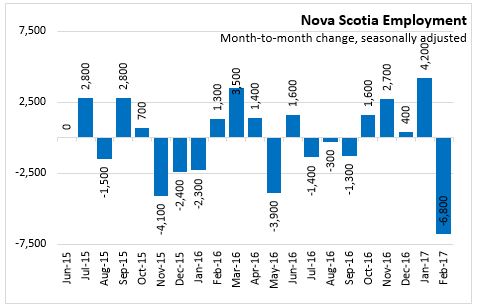
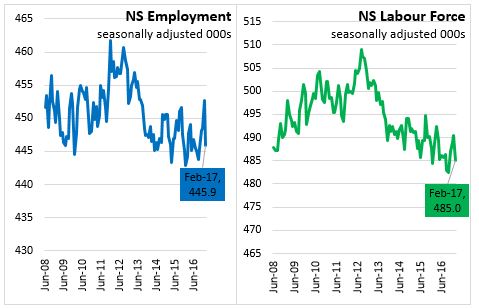
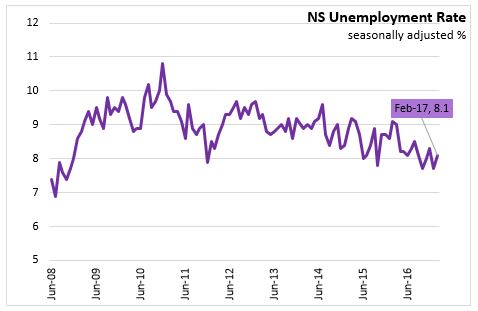
In February, the overall fall in employment reflects declines of both full-time employment (-1,200) and part-time employment (-5,500).
During the first two months of 2017 compared to the first two months of 2016, there was an increase of 5,800 jobs (1.3 per cent) in the average employment level. Average full time employment was down 2,000 while there were 7,800 more part-time workers. The labour force was up 1,100 for the first two months of 2017. With labour demand increasing at a faster pace than the labour supply, the net result was a drop in the average unemployment rate by 0.9 percentage points to 7.9 per cent. The labour force participation rate decreased 0.1 percentage points to 61.8 per cent. The employment rate climbed by 0.5 percentage points to 56.9 per cent.
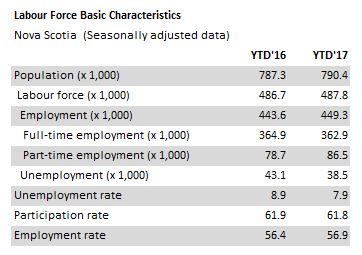
AGE COHORTS (January-February 2017 vs. January-February 2016)
The labour force survey population estimate of 15-24-year age group declined by 1,500 comparing the first two months of 2017 to first two months of 2016. The age group saw a decline of 4,300 in the labour force and 4,000 in employment during this period as the number of unemployed decreased. However, the unemployment rate increased 0.4 percentage points to 15.1 per cent for the first two months of 2017 over the same period in 2016. The larger decline in employment compared to the decline in population led to a 3.0 percentage point decline in the employment rate to 52.5 per cent.
For Nova Scotians aged 25 to 54, the labour force declined 1,500 while employment increased 3,700 comparing the first two months of 2017 to the first two months of 2016. With such a strong growth in labour demand overriding the fall in labour supply, the net result was a 1.7 percentage points drop in the unemployment to 6.4 per cent. The labour force participation rate climbed 0.4 percentage points to 86.2 per cent and the employment rate rose 1.8 percentage points to 80.7 per cent for this age group.
For those Nova Scotians aged 55 and over, the population, labour force and employment have all increased comparing the first two months of 2017 to the first two months of 2016. Employment increased by 6,100, slower than the rise in the labour force of 7,000, resulting in an increase in unemployment of 1,100 and an increase the unemployment rate of 0.5 percentage points to 7.8 per cent. The participation rate and employment rate both increased for this age group, rising to 34.8 per cent and 32.2 per cent.
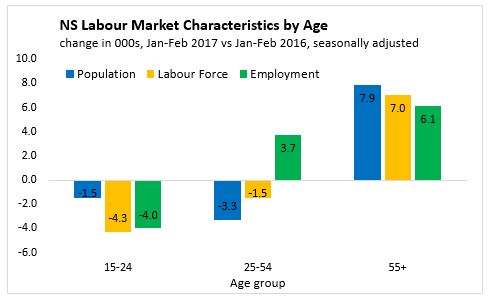
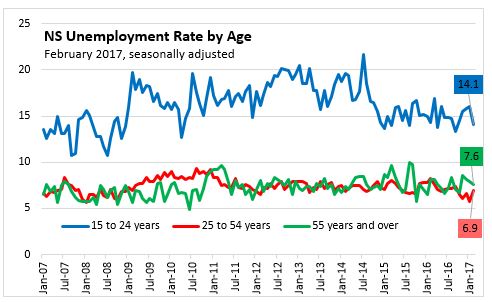
SECTORS (January-February 2017 vs. January-February 2016)
Comparing the first two months of 2017 to the first two months of 2016, employment in goods-producing sectors decreased by 900 jobs. Employment gains in agriculture, forestry/fishing, utilities and construction were not enough to offset a loss of 3,100 net jobs in the manufacturing sector.
There was a net gain of 6,600 jobs in service-producing sectors. Strong employment gains in wholesale/retail trade, health, professional services, and public administration were enough to override the job losses in financial services, educational, accommodation/food services and transportation and warehousing sector.
The increase in employment for the first two months of 2017 over the same period in 2016 occurred with employees increasing by 3,500 and the self-employed increasing by 2,300. The gain in employees occurred with a gain of 2,800 jobs in the private sector and a gain of 600 in public sector employees.

Regions (3 month moving average, January-February 2017 vs. January-February 2016)
For the first two months of 2017 compared to the first two months of 2016, the Halifax, Cape Breton and North Shore regions reported employment growth that outpaced labour force growth, resulting in lower average unemployment rates. The South Shore and the Annapolis Valley economic regions unemployment rates fell as the labour force (labour supply) declined at a faster pace than labour demand (employment).
The Cape Breton region reported an increase in employment of 3,200 (7.4 per cent) for the first two months of 2017 over the first two months of 2016. The labour force climbed by 1,700 (3.2 per cent) for the same period. With labour demand increasing at a faster pace than labour supply, the result was a 3.3 percentage point decrease in the unemployment rate to 14.1 per cent.
For the North Shore region, employment increased 1,000 (1.4 per cent) for the first two months of 2017 over the same period in 2016. Labour supply increased by 600 (0.7 per cent) for the same period. The increase in labour demand resulted in a 0.7 percentage point decline in the unemployment rate to 8.4 per cent.
The Annapolis region experienced a decline in employment of 700 (-1.3 per cent) followed by a fall in the labour force of 800 (-1.5 per cent) for the first two months of 2017 over the first two months of 2016. The net result was a decrease of 0.1 percentage points in the average unemployment rate to 8.0 per cent.
The Southern region saw employment fall by 1,100 (-2.2 per cent) and the labour force had a decline of 1,400 (-2.5 per cent) for the first two months of 2017 over the first two months of 2016. The unemployment rate was down 0.3 percentage points to 11.1 per cent.
Comparing the first two months of 2017 to the first two months of 2016, Halifax (HRM) experienced an increase in employment of 1,700 (0.8 per cent) along with an increase of 300 (0.1 per cent) in the labour supply. With labour market demand increasing at a faster pace than labour supply, the net impact was 0.7 percentage point decrease in the unemployment rate to 6.1 per cent.
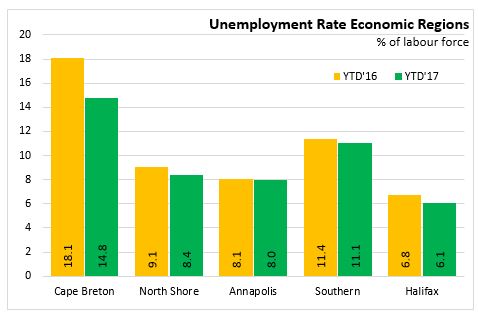
Provincial Comparisons
Employment increased 1.6 per cent in Canada comparing January-February 2017 with January-February 2016. Employment grew on a year-to-date basis in eight provinces with the largest gains in British Columbia (+3.6%) and Quebec (+2.2%). Two provinces had declines, Newfoundland and Labrador (-1.9%) and Alberta (-0.2%).
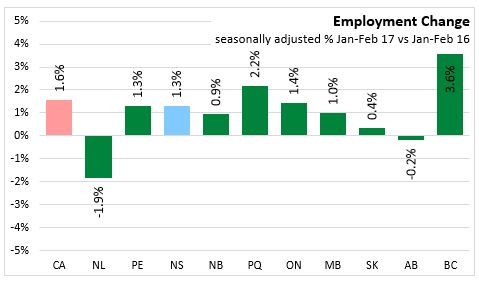
The Nova Scotia unemployment rate was 8.1 per cent in February 2017. In February of last year, the Nova Scotia unemployment rate was 9.1 per cent. Seven provinces have lower unemployment rates compared to last year with British Columbia (-1.4 percentage points) having the steepest declines. The lowest unemployment rate among the provinces in February 2017 was in British Columbia at 5.1 per cent while the highest was in Newfoundland and Labrador at 14.2 per cent.

National Comparisons: Cities
The seasonally adjusted unemployment rate for the Halifax Census Metropolitan Area was 6.1 per cent. Brantford (4.2%) had the lowest unemployment rate for a CMA this month.
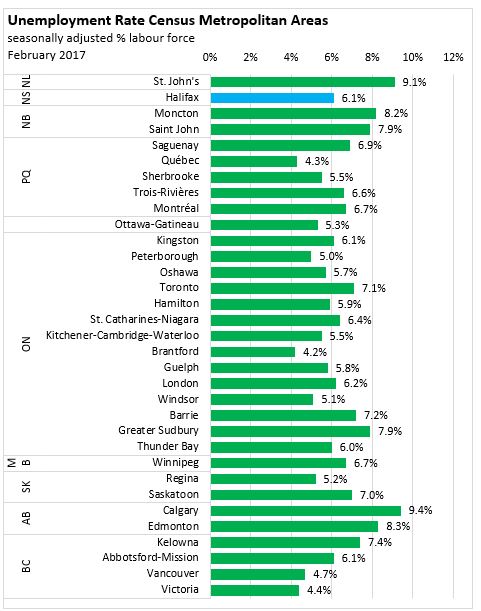
The seasonally adjusted employment rate for the Halifax Census Metropolitan Area was lower than last month at 63.1 per cent in February 2017.
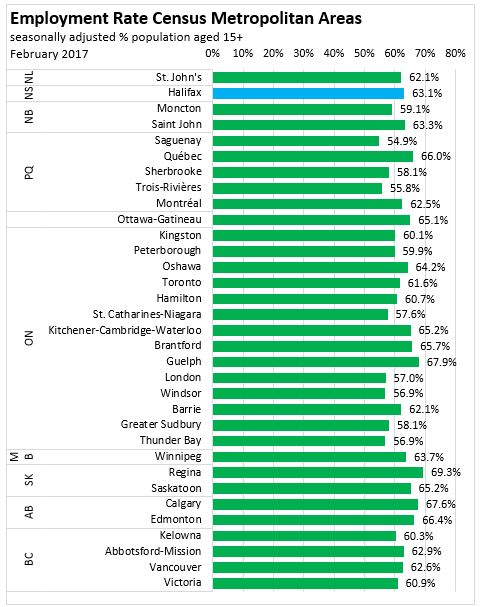
The three month average employment ending in February for the Halifax CMA declined 0.5 per cent compared to the three month period ending in January. The largest gain among CMAs was in Barrie, Ontario were employment rose 2.7 per cent.
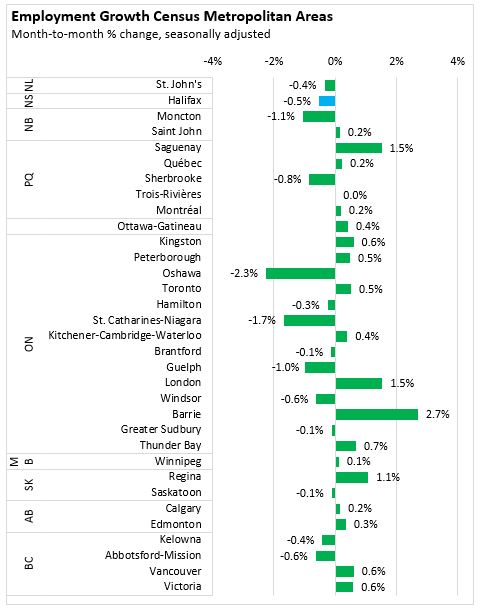

Note: Seasonally adjusted, 3 month average.